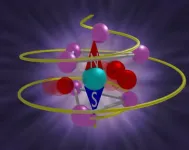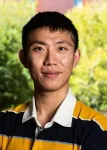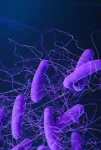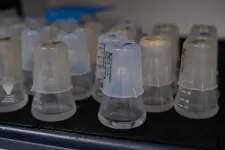(Press-News.org) Quantum materials hold the key to a future of lightning-speed, energy-efficient information systems. The problem with tapping their transformative potential is that, in solids, the vast number of atoms often drowns out the exotic quantum properties electrons carry.
Rice University researchers in the lab of quantum materials scientist Hanyu Zhu found that when they move in circles, atoms can also work wonders: When the atomic lattice in a rare-earth crystal becomes animated with a corkscrew-shaped vibration known as a chiral phonon, the crystal is transformed into a magnet.
According to a study published in Science, exposing cerium fluoride to ultrafast pulses of light sends its atoms into a dance that momentarily enlists the spins of electrons, causing them to align with the atomic rotation. This alignment would otherwise require a powerful magnetic field to activate, since cerium fluoride is naturally paramagnetic with randomly oriented spins even at zero temperature.
“Each electron possesses a magnetic spin that acts like a tiny compass needle embedded in the material, reacting to the local magnetic field,” said Rice materials scientist and co-author Boris Yakobson. “Chirality ⎯ also called handedness because of the way in which left and right hands mirror each other without being superimposable ⎯ should not affect the energies of the electrons’ spin. But in this instance, the chiral movement of the atomic lattice polarizes the spins inside the material as if a large magnetic field were applied.”
Though short-lived, the force that aligns the spins outlasts the duration of the light pulse by a significant margin. Since atoms only rotate in particular frequencies and move for a longer time at lower temperatures, additional frequency- and temperature-dependent measurements further confirm that magnetization occurs as a result of the atoms’ collective chiral dance.
“The effect of atomic motion on electrons is surprising because electrons are so much lighter and faster than atoms,” said Zhu, Rice’s William Marsh Rice Chair and an assistant professor of materials science and nanoengineering. “Electrons can usually adapt to a new atomic position immediately, forgetting their prior trajectory. Material properties would remain unchanged if atoms went clockwise or counterclockwise, i.e., traveled forward or backward in time ⎯ a phenomenon that physicists refer to as time-reversal symmetry.”
The idea that the collective motion of atoms breaks time-reversal symmetry is relatively recent. Chiral phonons have now been experimentally demonstrated in a few different materials, but exactly how they impact material properties is not well understood.
“We wanted to quantitatively measure the effect of chiral phonons on a material’s electrical, optical and magnetic properties,” Zhu said. “Because spin refers to electrons’ rotation while phonons describe atomic rotation, there is a naive expectation that the two might talk with each other. So we decided to focus on a fascinating phenomenon called spin-phonon coupling.”
Spin-phonon coupling plays an important part in real-world applications like writing data on a hard disk. Earlier this year, Zhu’s group demonstrated a new instance of spin-phonon coupling in single molecular layers with atoms moving linearly and shaking spins.
In their new experiments, Zhu and the team members had to find a way to drive a lattice of atoms to move in a chiral fashion. This required both that they pick the right material and that they create light at the right frequency to send its atomic lattice aswirl with the help of theoretical computation from the collaborators.
“There is no off-the-shelf light source for our phonon frequencies at about 10 terahertz,” explained Jiaming Luo, an applied physics graduate student and the lead author of the study. “We created our light pulses by mixing intense infrared lights and twisting the electric field to ‘talk’ to the chiral phonons. Furthermore, we took another two infrared light pulses to monitor the spin and atomic motion, respectively.”
In addition to the insights into spin-phonon coupling derived from the research findings, the experimental design and setup will help inform future research on magnetic and quantum materials.
“We hope that quantitatively measuring the magnetic field from chiral phonons can help us develop experiment protocols to study novel physics in dynamic materials,” Zhu said. “Our goal is to engineer materials that do not exist in nature through external fields ⎯ such as light or quantum fluctuations.”
The research was supported by the National Science Foundation (2005096, 1842494, 2240106), the Welch Foundation (C-2128) and the Army Research Office (W911NF-16-1-0255).
-30-
This release can be found online at news.rice.edu.
Follow Rice News and Media Relations via Twitter @RiceUNews.
Peer-reviewed paper:
“Large effective magnetic fields from chiral phonons in rare-earth halides” | Science | DOI: 10.1126/science.adi9601
Authors: Jiaming Luo, Tong Lin, Junjie Zhang, Xiaotong Chen, Elizabeth Blackert, Rui Xu, Boris Yakobson and Hanyu Zhu
http://www.science.org/doi/10.1126/science.adi9601
Animation:
https://youtu.be/5pvuq_5SEX4
CAPTION: Chiral phonons excited by the circularly polarized terahertz light pulses generate ultrafast magnetization in cerium fluoride. Fluorine ions (red, fuchsia) are set into motion by circularly polarized terahertz light pulses (yellow spiral), where red denotes the ions with the largest motion in the chiral phonon mode. The cerium ion is represented in teal. The compass needle represents the magnetization induced by the rotating atoms. (Animation courtesy of Mario Norton and Jiaming Luo/Rice University)
Image Downloads:
https://news-network.rice.edu/news/files/2023/11/illustration.jpg
CAPTION: Chiral phonons excited by the circularly polarized terahertz light pulses generate ultrafast magnetization in cerium fluoride. Fluorine ions (red, fuchsia) are set into motion by circularly polarized terahertz light pulses (yellow spiral), where red denotes the ions with the largest motion in the chiral phonon mode. The cerium ion is represented in teal. The compass needle represents the magnetization induced by the rotating atoms. (Image courtesy of Mario Norton and Jiaming Luo/Rice University)
https://news-network.rice.edu/news/files/2023/11/230919_zhu_Fitlow_7594.jpg
CAPTION: Hanyu Zhu is the William Marsh Rice Chair and assistant professor of materials science and nanoengineering at Rice University. (Photo by Jeff Fitlow/Rice University)
https://news-network.rice.edu/news/files/2023/11/230919_zhu_Fitlow_7564.jpg
CAPTION: Jiaming Luo is a Rice graduate student in applied physics and a lead author on the study. (Photo by Jeff Fitlow/Rice University)
https://news-network.rice.edu/news/files/2023/11/230919_zhu_Fitlow_7554.jpg
CAPTION: Tong Lin (from left), Hanyu Zhu and Jiaming Luo at EQUAL lab. (Photo by Jeff Fitlow/Rice University)
https://news-network.rice.edu/news/files/2023/11/230302_yakobson_Fitlow_412-14.jpg
CAPTION: Boris Yakobson is Rice’s Karl F. Hasselmann Professor of Engineering and a professor of materials science and nanoengineering and of chemistry. (Photo by Jeff Fitlow/Rice University)
Related stories:
Discovery may lead to terahertz technology for quantum sensing:
https://news.rice.edu/news/2023/discovery-may-lead-terahertz-technology-quantum-sensing
Bending 2D nanomaterial could ‘switch on’ future technologies:
https://news.rice.edu/news/2023/bending-2d-nanomaterial-could-switch-future-technologies#:~:text=%E2%80%9CSo%20instead%20of%20remaining%20flat,means%20you%20have%20an%20actuator.
Rice’s Hanyu Zhu wins NSF CAREER Award:
https://msne.rice.edu/news/hanyu-zhu-receives-nsf-career-award
Links:
Zhu lab: https://zhugroup.rice.edu/
Yakobson Research Group: https://biygroup.blogs.rice.edu/
Department of Materials Science and NanoEngineering: msne.rice.edu
George R. Brown School of Engineering: https://engineering.rice.edu
Located on a 300-acre forested campus in Houston, Rice University is consistently ranked among the nation’s top 20 universities by U.S. News & World Report. Rice has highly respected schools of Architecture, Business, Continuing Studies, Engineering, Humanities, Music, Natural Sciences and Social Sciences and is home to the Baker Institute for Public Policy. With 4,574 undergraduates and 3,982 graduate students, Rice’s undergraduate student-to-faculty ratio is just under 6-to-1. Its residential college system builds close-knit communities and lifelong friendships, just one reason why Rice is ranked No. 1 for lots of race/class interaction, No.2 for best-run colleges and Np.12 for quality of life by the Princeton Review. Rice is also rated as a best value among private universities by Kiplinger’s Personal Finance.
END
Atomic dance gives rise to a magnet
Rice study leverages chiral phonons for transformative quantum effect
2023-11-09
ELSE PRESS RELEASES FROM THIS DATE:
Milky Way-like galaxy found in the early universe
2023-11-09
Using the James Webb Space Telescope, an international team, including astronomer Alexander de la Vega of the University of California, Riverside, has discovered the most distant barred spiral galaxy similar to the Milky Way that has been observed to date.
Until now it was believed that barred spiral galaxies like the Milky Way could not be observed before the universe, estimated to be 13.8 billion years old, reached half of its current age.
The research, published in Nature this week, was led by scientists at the Centro de Astrobiología in Spain.
“This galaxy, named ceers-2112, formed soon after ...
Side-effect avoiding treatment shows early promise against breast cancer in mice
2023-11-09
New experimental evidence suggests that substances known as narrow-spectrum Wnt signaling inhibitors—which could have fewer side effects than other related substances—are capable of suppressing the growth of breast cancer tumors in mice. Aina He of Shanghai Jiaotong University Affiliated Sixth People’s Hospital, China, and colleagues present these findings November 9th in the open access journal PLOS Biology.
While certain subtypes of breast cancer can be targeted with special medications, others can only be treated with standard chemotherapy. For some patients, chemotherapy may lead to the growth of stem cell-like cancer cells that are drug resistant. Previous ...
Bacteria-virus arms race provides rare window into rapid and complex evolution
2023-11-09
As conceived by Charles Darwin in the 1800s, evolution is a slow, gradual process during which species adaptations are inherited incrementally over generations. However, today biologists can see how evolutionary changes unfold on much more accelerated timescales.
Rather than the evocative plants and animals of the Galapagos Islands that Darwin studied in forming his theory of evolution, Postdoctoral Scholar Joshua Borin and Associate Professor Justin Meyer of UC San Diego’s School of Biological Sciences are documenting rapid evolutionary processes in simple laboratory flasks.
Borin ...
Open-science “COVID Moonshot” discovers new antivirals to treat COVID-19
2023-11-09
Although the group’s work has been freely available since its inception in March 2020, the COVID Moonshot Consortium is finally formally reporting their results. The COVID Moonshot – an open-science, crowdsourced, and patent-free drug discovery campaign targeting the SARS-CoV-2 virus – has yielded a wealth of data on the virus’s main protease, including insights that could pave the way for the development of new and better therapeutics. “The lead therapeutics described by [these researchers] may not be ready in time to affect the current pandemic, considering the timelines and challenges of drug approval,” write Brian Shoichet and Charles ...
Shrinking a mode-locked laser to the size of an optical chip
2023-11-09
Setting out to improve a technology that usually requires bulky, bench-top equipment, Quishi Guo and colleagues have shrunk a mode-locked laser (MLL) to the size of an optical chip with an integrated nanophotonic platform. The results show promise for developing ultrafast nanophotonic systems for a wide range of applications. Mode-locked lasers (MLLs) can produce coherent ultrashort pulses of light at extremely fast speeds – on the order of picoseconds and femtoseconds. These devices have enabled numerous technologies in photonics, including extreme nonlinear optics, two-photon microscopy, ...
Wildfire risk to US homes is rising, especially in western grasslands and shrublands
2023-11-09
Drawing on 30 years of data, researchers show that the number of homes within wildfire perimeters in the U.S. has doubled since the 1990s. This increasing risk is driven by both an increase in wildfires and the expansion of new homes into wildfire-prone areas, especially in the wildland-urban interface. Wildfire risks to homes are increasing, particularly in the wildland-urban interface (WUI), where houses and wildland vegetation are in close proximity. Over the last 12 years, more than 55,000 homes in the U.S. have been lost to wildfires due to rapid increases ...
Introducing: Ceramic- and glass-based passive radiative cooling materials resistance to harsh environments
2023-11-09
Two studies highlight new glass- and ceramic-based passive radiative cooling materials. Unlike passive radiative cooling approaches that rely on polymers, these hard materials are more durable and versatile, making them more attractive for a wide range of outdoor passive cooling applications, including those that could help reduce the need for air conditioning. The energy demand for cooling continues to rise, particularly in regions rapidly warming due to climate change. To make matters worse, the growing carbon footprint of cooling systems further contributes to global warming, exacerbating the need for cooling solutions. Passive radiative cooling (PRC) materials, which ...
Researchers identify previously unknown step in cholesterol absorption in the gut
2023-11-09
UCLA researchers have described a previously unknown step in the complex process by which dietary cholesterol is processed in the intestines before being released into the bloodstream – potentially revealing a new pathway to target in cholesterol treatment.
Although an existing drug and statins impact part of the process, an experimental drug being studied in UCLA research labs appears to specifically target the newfound pathway, possibly adding a new approach to the cholesterol management toolbox.
“Our results show that certain proteins in the Aster family play a critical role in moving cholesterol through the absorption and uptake process,” said ...
Desert birds lay larger eggs when they have more helpers
2023-11-09
Desert birds lay larger eggs when they have more helpers to feed their chicks, new research shows.
White-browed sparrow weavers live in family groups in which only a dominant pair breeds and their grown-up offspring, particularly females, help to feed nestlings.
The study, by researchers at the University of Exeter, found that mothers increased the size of their eggs when they had more female helpers on hand.
The number of male helpers did not affect egg size, probably because male helpers feed chicks at substantially lower rates than female helpers.
“We don’t yet fully understand why helped mothers are laying heavier ...
Ethical, environmental and political concerns about climate change affect reproductive choices
2023-11-09
People are beginning to reconsider their reproductive decisions due to complex concerns about climate change, with many choosing to forego childbearing, or reduce the number of children they have as a result, finds a new study by UCL researchers.
The research, published in PLOS Climate, is the first systematic review to explore how and why climate change-related concerns may be impacting reproductive decision-making.
The team examined 13 studies, involving 10,788 participants, which were conducted between 2012 and 2022, primarily in Global North countries ...
LAST 30 PRESS RELEASES:
Numbers in our sights affect how we perceive space
SIMJ announces global collaborative book project in commemoration of its 75th anniversary
Air pollution exposure and birth weight
Obstructive sleep apnea risk and mental health conditions among older adults
How talking slows eye movements behind the wheel
The Ceramic Society of Japan’s Oxoate Ceramics Research Association launches new international book project
Heart-brain connection: international study reveals the role of the vagus nerve in keeping the heart young
Researchers identify Rb1 as a predictive biomarker for a new therapeutic strategy in some breast cancers
Survey reveals ethical gaps slowing AI adoption in pediatric surgery
Stimulant ADHD medications work differently than thought
AI overestimates how smart people are, according to HSE economists
HSE researchers create genome-wide map of quadruplexes
Scientists boost cell "powerhouses" to burn more calories
Automatic label checking: The missing step in making reliable medical AI
Low daily alcohol intake linked to 50% heightened mouth cancer risk in India
American Meteorological Society announces Rick Spinrad as 2026 President-Elect
Biomass-based carbon capture spotlighted in newly released global climate webinar recording
Illuminating invisible nano pollutants: advanced bioimaging tracks the full journey of emerging nanoscale contaminants in living systems
How does age affect recovery from spinal cord injury?
Novel AI tool offers prognosis for patients with head and neck cancer
Fathers’ microplastic exposure tied to their children’s metabolic problems
Research validates laboratory model for studying high-grade serous ovarian cancer
SIR 2026 delivers transformative breakthroughs in minimally invasive medicine to improve patient care
Stem Cell Reports most downloaded papers of 2025 highlight the breadth and impact of stem cell research
Oxford-led study estimates NHS spends around 3% of its primary and secondary care budget on the health impacts of heat and cold in England
A researcher’s long quest leads to a smart composite breakthrough
Urban wild bees act as “microbial sensors” of city health.
New study finds where you live affects recovery after a hip fracture
Forecasting the impact of fully automated vehicle adoption on US road traffic injuries
Alcohol-related hospitalizations from 2016 to 2022
[Press-News.org] Atomic dance gives rise to a magnetRice study leverages chiral phonons for transformative quantum effect






